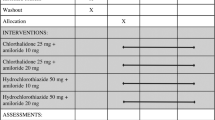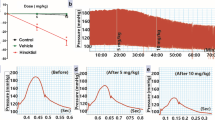Summary
In an open study increasing doses of a retarded tablet formulation of pinacidil were given twice daily for four weeks to 9 patients with untreated essential hypertension (WHO I–II). In all patients a decrease in diastolic blood pressure to below 100 mmHg, or a fall exceeding 15 mmHg, was obtained 2 h after tablet intake (p<0.02), but in only two patients was the effect maintained after 10 hours (n.s.). At a mean serum concentration of 100 ng/ml 2 h after pinacidil 30 mg, the mean blood pressure had decreased by 14 and 12.7 mmHg in the supine and erect positions, respectively (p<0.05). In contrast, mean blood pressure 10 h after the same dose was unchanged, when the mean serum concentration was 47.5 ng/ml. No change in heart rate was observed. Pharmacokinetic and pharmacodynamic investigations showed a tendency towards a more gradual and longer lasting antihypertensive effect and serum concentration-time curve after the retarded tablet than the previous tablet. Pinacidil 40 mg in the retarded tablet reduced mean blood pressure and increased heart rate for at least 8 h. There was a linear correlation between the serum concentration and the changes in mean blood pressure, and between the changes in mean blood pressure and in heart rate. There was no indication of tachyphylaxis. A serum level of 50 ng/ml of pinacidil appeared to be the minimal effective concentration. The side effect consisted of fluid retention, and the body weight increased by 1.0 kg (p<0.05); four patients complained of oedema. Therapy was discontinued in one patient after a fainting episode following an increase in the dose. Thus, pinacidil was able to lower blood pressure during monotherapy for 4 weeks provided that an adequate serum concentration was achieved. The present retarded tablet formulation is not suitable for b. d. dosing. The tendency towards fluid-retention suggests that pinacidil should be used in combination with a diuretic.
Similar content being viewed by others
References
Arrigoni-Martelli E, Nielsen, CK, Olsen UB, Petersen HJ (1980) N″-cyano-N-4-pyridyl-N′-1,2,2-trimethylpropylguanidine, monohydrate (P 1134): A new, potent vasodilator. Experientia 36: 445–447
Carlsen J, Kardel T, Hilden T, Tangø M, Trap-Jensen J (1981) Immediate central and peripheral haemodynamic effects of P 1134, a new vasodilating agent in hypertensive man. Clin Physiol 1: 375–384
Engberg-Pedersen H (1974) Empirical equation for pharmacokinetic analysis of drug serum levels after oral application. Antimicrob Agents Chemother 6: 554–562
Ibsen H, Rasmussen K, AErenlund Jensen H, Leth A (1978) Changes in plasma volume and extracellular fluid volume after addition of hydralazine to propranolol treatment in patients with hypertension. Acta Med Scand 203: 419–423
Kardel T, Hilden T, Carlsen J, Trap-Jensen J (1981) P 1134, a new vasodilating agent. Acute effects on blood pressure and pharmacokinetics in hypertensive patients. J Cardiovasc Pharmacol 3: 1002–1007
Koch-Weser J (1976) Hydralazine. N Engl J Med 295: 320–322
Petersen HJ, Nielsen CH, Arrigoni-Martelli E (1978) Synthesis and hypotensive activity of N-alkyl-N″-cyano-N′ pyridyl guanidines. J Med Chem 21: 773–781
Tarazi RC, Dustan Harriet, Bravo EL, Niarchos AP (1976) Vasodilating drugs: Contrasting haemodynamic effects. Clin Sci Mol Med 51: 575s-578s
Åblad B (1963) A study of the mechanism of the haemodynamic effects of hydralazine in man. Acta Pharmacol Toxicol 20 [Suppl 1]: 1–53
Author information
Authors and Affiliations
Rights and permissions
About this article
Cite this article
Carlsen, J.E., Kardel, T., Jensen, H.Æ. et al. Pinacidil, a new vasodilator: Pharmacokinetics and pharmacodynamics of a new retarded release tablet in essential hypertension. Eur J Clin Pharmacol 25, 557–561 (1983). https://doi.org/10.1007/BF00542128
Received:
Revised:
Accepted:
Issue Date:
DOI: https://doi.org/10.1007/BF00542128




